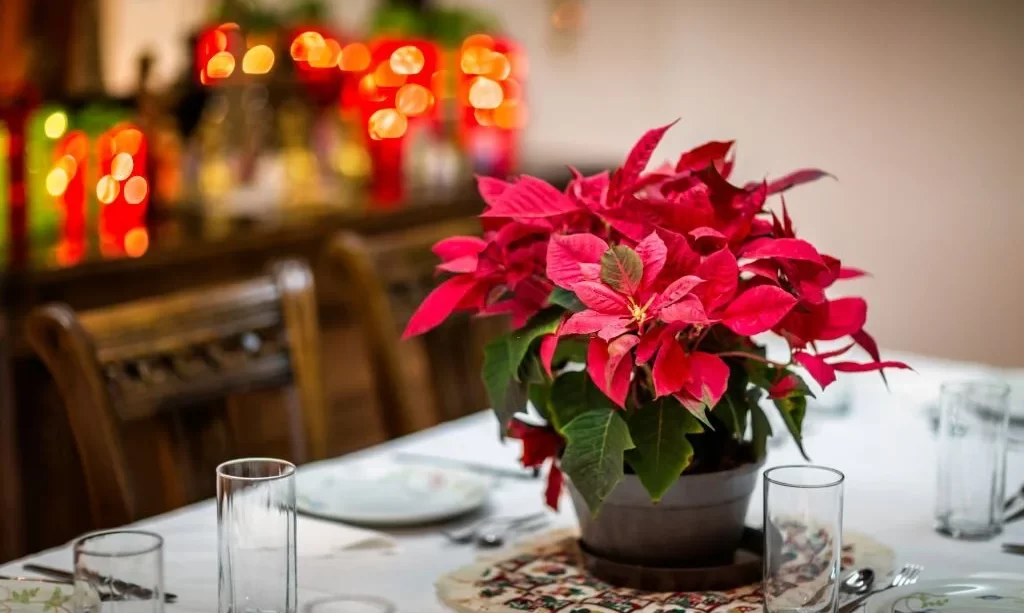Poinsettias, with their stunning red and green foliage, are undeniably synonymous with the holiday season. These iconic plants add a touch of festive cheer to homes, offices, and events during the winter months. However, what many don’t realize is that poinsettias can thrive long after the holiday decorations are put away. In this guide, we’ll delve into the art of caring for poinsettia plants after Christmas, ensuring they continue to flourish throughout the year. Discover the steps and tips to transform your holiday poinsettias into long-lasting botanical beauties.
- Professional Liquid Fertilizer for: Poinsettia varieties (Euphorbia pulcherrima)
- This food for plants belongs to the latest generation of fertilizers, for healthy leaves, stable and strong formation, balanced rooting, beautiful flowers.
- Very rapid effects, can be administered via the roots and as a foliar fertilizer. For 60-125 liters of ready to use liquid fertilizer
- Content: 250 ml, works as an economical concentrate. Simple dosage with the help of the cap.
- The fertilizers from the GREEN24 PROFI LINE were developed by gardeners of various departments and were evolved and produced based on the current knowledge in the field of propagation and cultivation of plants.
The Holiday Season
- Poinsettia as a Holiday Tradition: Poinsettias have earned their place as a cherished holiday tradition. Their vibrant red and green leaves evoke the festive spirit, making them a popular choice for decorating homes, offices, and public spaces during the holiday season.
- Temporary Nature of Decorations: While poinsettias are often used as decorative accents, it’s essential to remember that their role in holiday decor is temporary. After the holiday festivities conclude, these plants deserve the opportunity to thrive and grace your space with their beauty year-round.
As we journey through this guide, you’ll discover the strategies and care routines required to nurture your poinsettias beyond the holiday season, ensuring they continue to thrive and potentially re-bloom for many Christmases to come.
Immediate Post-Holiday Period
- Transitioning from Holiday Decor: As the holiday season comes to a close, it’s time to transition your poinsettia from its role as a holiday decoration. Remove any decorative wrapping or containers and examine the plant’s condition.
- Pruning: To encourage bushier growth and maintain a more compact size, prune the poinsettia back to about 6-8 inches in height. Be sure to make clean cuts just above a leaf node.
- Repotting (Optional): If the poinsettia has outgrown its current container, consider repotting it into a slightly larger pot with well-draining potting soil. However, be cautious not to choose a pot that is too large, as poinsettias prefer slightly snug conditions.
Extended Care
- Light Requirements: Poinsettias need consistent, bright, indirect sunlight year-round. Place them near a sunny window where they receive at least six hours of indirect sunlight daily. Adequate light is crucial for the plant’s health and potential re-blooming.
- Temperature: Maintain a consistent temperature between 60°F to 70°F (15°C to 24°C). Avoid exposing the poinsettia to drafts, sudden temperature fluctuations, or extreme heat or cold.
- Watering: Water the poinsettia when the top inch of soil feels dry to the touch. Ensure that the pot has proper drainage to prevent waterlogging, which can lead to root rot.
- Fertilizing: During the growing season (spring and summer), feed your poinsettia with a balanced, water-soluble fertilizer every 2-4 weeks. Reduce or stop fertilizing in the fall and winter when growth slows down.
- Pruning and Maintenance: Continue to prune the poinsettia as needed to maintain its shape and size. Remove any dead or yellowing leaves and spent flowers promptly.
By providing the appropriate post-holiday care and extending your nurturing efforts into the following months, you can transform your poinsettia into a thriving and potentially re-blooming plant that brings beauty to your space throughout the year.
Beyond the Holidays
- Encouraging Re-blooming: If you want your poinsettia to bloom again for the next holiday season, it requires a specific treatment starting in early fall. Around October 1st, cover the plant with a lightproof bag or place it in a dark room for about 14-16 hours each night. This extended darkness stimulates the colorful bracts’ development.
- Resuming Normal Care: After the period of darkness, usually in late November or early December, return your poinsettia to its regular care routine, including bright, indirect sunlight and proper watering.
Poinsettia Lifespan
- Longevity: With diligent care and attention, poinsettias can live for several years, offering their festive beauty during the holiday season and beyond.
- Growth and Pruning: Continue to prune and shape the plant as needed to maintain its desired size and appearance. Well-cared-for poinsettias can grow larger and more lush over time.
Conclusion
Poinsettias may be holiday symbols, but with the right care and attention, they can evolve from short-lived decorations into long-lasting botanical companions. By understanding their needs during the immediate post-holiday period, providing extended care year-round, and following the steps to encourage re-blooming, you can ensure that your poinsettia thrives and continues to grace your space with its vibrant beauty.
Remember that poinsettia care is a year-round commitment, and it rewards your efforts with the potential for stunning displays of color each holiday season. With this guide, you’re equipped to transform your poinsettia from a seasonal decor piece into a cherished perennial that brightens your home throughout the year.




